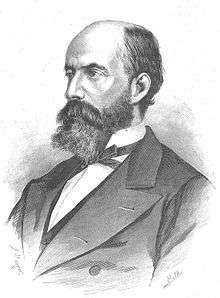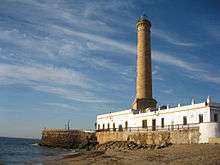Eduardo Saavedra
Eduardo Saavedra (Spanish: Eduardo Saavedra y Moragas; February 1829, in Tarragona – 12 March 1912 in Madid[1]), Spanish engineer, architect, archaeologist and Arabist, member of the Real Academia de la Historia, Spanish Royal Academy of Sciences, Real Academia Española and cofounder-president of the Real Sociedad Geográfica.
Eduardo Saavedra | |
|---|---|
 | |
| Born | Eduardo Saavedra y Moragas 1829, 27 February |
| Died | 1912, 12 March |
| Nationality | Spanish |
Biography
In 1857 Eduardo Saavedra designed the highest lighthouse in Spanin - Chipiona Light. In 1860 he discovered Numantia ruins in the province of Soria and was the chairman of the committee that dealt with the archaeological excavations. While working on the project of roads between Soria and the Burgo de Osma-Ciudad de Osma he discovered the Roman road between Uxama Argaela and Augustóbriga.

Lighthouse of Chipiona, project by Eduardo Saavedra
Archeological Studies
- "Descripción de la vía romana entre Uxama y Augustóbriga", en Memorias de la Real Academia de la Historia, vol. 9, 1879
Arabic Studies
- La Geografía de España de El Idrisí, Madrid, 1881.
- Intereses de España en Marruecos, Madrid, 1884.
- Estudio sobre la invasión de los árabes en España, Madrid, 1891.
- La mujer mozárabe, Madrid, 1904.
Bibliography
- Mañas Martínez, José (1983), Eduardo Saavedra, Ingeniero y Humanista; prólogo de Julio Caro Baroja, Madrid:Turner-Colegio de Ingenieros de Caminos, Canales y Puertos.
- Manzanares de Cirre, Manuela (1972), Arabistas españoles del siglo XIX, Madrid, Instituto Hispano-Árabe de Cultura.
- Pasamar Alzuria, Gonzalo; Peiró Martín, Ignacio (2002). Diccionario Akal de Historiadores españoles contemporáneos. Ediciones Akal. ISBN 9788446014898.
References
- Pasamar Alzuria y Peiró Martín, 2002, p. 551.
External links
| Wikimedia Commons has media related to Eduardo Saavedra. |
- Obras de Eduardo Saavedra en la Biblioteca Virtual Cervantes
- Eduardo Saavedra en Biografías y vidas
- La ingeniería española y el Canal de Suez. El primer viaje de una fragata española a través del canal (1869) : Exposición Universidad Politécnica de Madrid
This article is issued from Wikipedia. The text is licensed under Creative Commons - Attribution - Sharealike. Additional terms may apply for the media files.